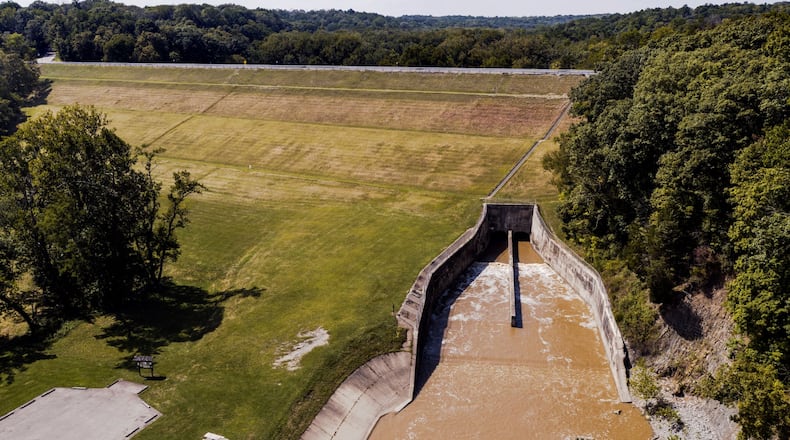There are hundreds of thousands of people in the Great Miami River watershed, including much of Montgomery, Butler, Clark and Miami counties. Runoff from their properties feeds the river, and they benefit from roads and facilities in the floodplain.
Facing $140 million in capital needs, the MCD proposed massive increased assessments for the properties currently paying. After public outcry, the district agreed to smaller increases and is looking at expanding who pays for flood protection.
The flood protection charge is an assessment, not a tax, though it shows up on the county tax bill. The decision of how much — and who — to charge rests with the Conservancy Court, which consists of nine common pleas court judges from counties covered by the Miami Conservancy District.
The district stresses that any decision follows periods of public comment and other outreach efforts planned by the conservancy district.
Credit: Nick Graham
Credit: Nick Graham
A leader of the public pushback over previous proposed increases was David Stark, who formed the Keep Hamilton Afloat campaign. He challenged flood assessment rates and called on officials to consider other paths for charging properties for flood protection.
Stark, who owns Artspace Lofts in Hamilton, said this month that the updated assessment charges will see his property’s bill double. He’s hoping to see an option out of the study that would charge a flat rate for every parcel in the region.
“To me, that seems like the only real and fair way to do this. Everybody in the county benefits from the fact that our bridges don’t flood out or collapse, and that parts of our county don’t flood,” he said.
Spreading it out that wide would keep the cost per-parcel as low as possible, he said.
Flood protection assessments
After increases last year, the Miami Conservancy District’s current assessments include a 3.35% maintenance assessment and a 1% capital assessment. This will generate more than $10 million annually to cover operation costs and the beginning phases of large-scale work.
Those bills were sent to the owners of roughly 39,000 property owners, with a payment deadline of Feb. 14.
The increased maintenance assessment, up from 2.19%, is intended to be a temporary uptick while they come up with a long-term funding plan.
The district originally proposed updating the values used to assess properties in the current floodplain, but that led to massive increases for some property owners. A Dayton Daily News analysis found hundreds of properties were looking at charges over $1,000 a year; dozens of properties could have paid more than $10,000 per year; one property owner was on the hook for roughly $478,000.
Credit: Nick Graham
Credit: Nick Graham
A pause in the reappraisal came after Ohio lawmakers asked for a delay in the process in a letter to the district and public outcry from property owners in Butler County.
The Miami Conservancy District instead said it would study how it could charge properties in the Great Miami River Watershed for flood protection. It recently completed the study’s first phase.
“The benefit assessment study that we’re doing is looking broader. We’ve identified more benefits,” said Miami Conservancy District general manager MaryLynn Lodor. “We recognize that there’s limited dollars to go around, and we are good stewards of those dollars. We’re responsible for ensuring the protection of our communities, of our businesses and for the region.”
Charging for flood protection
The first phase of the analysis, coordinated by engineering firm Stantec Inc., found that the Miami Conservancy District has a unique approach to how it charges property owners for flood protection when compared to other conservancy districts in Ohio, as well as other U.S. flood control districts.
The Miami Conservancy District uses a formula that multiplies the benefit properties receive from the flood protection system by the rates the district charges for the assessments. To do this, the district calculated a property’s “flood factor” by using mapping technology. Only properties that were flooded during the Great Flood of 1913 are currently charged for flood protection.
The study identified several other methods the conservancy district could use to charge properties for benefits, said Lodor.
This includes methods that consider a property’s stormwater runoff without weighing a property’s overall value into the equation. Other alternatives could factor in property value, but classify properties into several “zones” of flood protection.
The methodology the conservancy district moves forward with could also be a blend of these options.
Lodor said the conservancy district is also analyzing how many properties are protected by or benefitting from the flood protection system, even if they are outside the area impacted by Dayton’s historic flood. Many critical services, like hospitals, major roads, bridges and other infrastructure that residents utilize are located on the riverfront, for example.
Lodor said changes to maintenance rates and changes to the district’s approach to charging properties would have to be approved by its board and also the Conservancy Court. No public vote is required, but Lodor said there would be a period of public comment.
Riverfront development
In Hamilton, Stark’s Artspace Lofts will see a $1,189 increase in flood protection charges under the assessment rates increased last year ― down significantly from the originally proposed rate increase that would have seen the space paying $10,810 annually.
Stark said he’s doing everything he can to keep rent from rising. This includes cutting art programming that he says adds to the vibrancy of the Hamilton area.
“I — and I think, others — can suffer and sustain this doubling of the burden in the short-term,” he said. “But we would love to receive assurances that this will, in fact, be only in the short-term, and that this will be fully spread across the district moving forward.”
Lodor said water quality and flood protection are closely tied to the region’s economic development.
For years following the Great Flood of 1913, which saw hundreds of people die and thousands more displaced, the rivers running through the region were looked at in fear, not with hope for growth.
Lodor said the “good work” of those who came before us to clean up the river and construct a thoughtful flood protection system set the region up for success, but it also reaffirms why protecting the system is an important duty.
“(Our water) made it an opportunity for the area to be a destination,” Lodor said. “It really is a competitive advantage. And we have a resilient flood protection system. It was designed with a lot of care and intention. It’s our responsibility to take care of it so that it can continue to be a place where people can grow and thrive.”
By the Numbers:
39,000: Number of property owners currently paying assessments
3.35%: The maintenance assessment rate
1%: The capital assessment rate
2012: The year of the last reappraisal
About the Author



